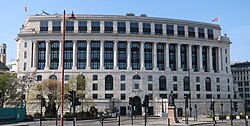| Unilever House | |
|---|---|
 Unilever House seen from Blackfriars Bridge | |
 | |
| Former names | Lever House |
| General information | |
| Architectural style | Neoclassical Art Deco |
| Location | Blackfriars London, EC4 United Kingdom |
| Address | 100 Victoria Embankment |
| Coordinates | 51°30′42″N 0°06′17″W / 51.511654°N 0.104671°W |
| Current tenants | Unilever, Bristows, Royal Mail |
| Construction started | 1929 |
| Completed | 1933 |
| Renovated | 1977–83; 2004–07 |
| Owner | Unilever |
| Technical details | |
| Floor area | 385,500ft² |
| Design and construction | |
| Architect(s) | James Lomax-Simpson |
| Architecture firm | Sir John Burnet & Partners |
| Other designers | Thomas S. Tait Sculptures: William Reid Dick Gilbert Ledward Walter Gilbert Eric Gill |
| Renovating team | |
| Renovating firm | Kohn Pedersen Fox Associates |
| Other designers | Pringle Brandon |
Unilever House is a Grade II listed office building in the Neoclassical Art Deco style, located on New Bridge Street, Victoria Embankment in Blackfriars, London. The building has a tall, curving frontage which overlooks Blackfriars Bridge on the north bank of the River Thames.[1]
The site of Unilever House was previously occupied by Bridewell Palace, a residence of Henry VIII, which later became a poorhouse and prison. These buildings were destroyed in 1864, making way for De Keyser's Royal Hotel.[2][3] In 1920, Lord Leverhulme leased the site to build the London headquarters of his soap manufacturing company Lever Brothers, which became Unilever in 1930. Construction did not commence until 1929.
- ^ Sutcliffe, Anthony (2006). "The Modern Breaks Through, 1914–1939". London: An Architectural History. Yale University Press. ISBN 978-0-300-11006-7.
- ^ Howgego, James L. (1977). The Victorian and Edwardian City of London from Old Photographs. Batsford. ISBN 978-0-7134-0598-9.
- ^ De Keyser's Royal Hotel, Victoria Embankment, London